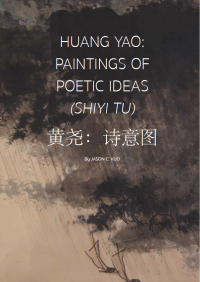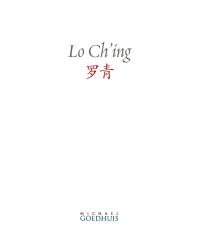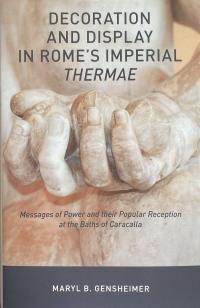Dr. Abigail McEwen contributes essay to 150th anniversary publication of Arts Student League (NYC)
Olga Albizu's training and work come to life in Dr. McEwen's essay


Research in art history and archaeology is an interdisciplinary enterprise.
We're here for Diversity, Equity, and Justice



Across the Roman Empire, ubiquitous archaeological, art historical, and literary evidence attests to the significance of bathing for Romans' daily routines. Given the importance of bathing to the Roman style of living, imperial patrons enhanced their popular and political stature by endowing eight magnificent baths (the so-called imperial thermae) in the city of Rome between 25 B.C.E. and 315 C.E. This book presents a detailed analysis of the decoration of the best preserved of these bathing complexes, the Baths of Caracalla (inaugurated 216 C.E.). An interdisciplinary approach to the archaeological data, to the textual and visual sources, and to anthropological theories facilitates new understandings of the visual experience of the Baths of Caracalla for a diverse Roman audience and simultaneously elucidates the decoration's critical role in advancing imperial agendas. This reassessment of one of the most sophisticated examples of architectural patronage in Classical antiquity examines the specific mechanisms through which an imperial patron could use architectural decoration to emphasize his sociopolitical position relative to the thousands of people who enjoyed his benefaction. The case studies addressed herein, ranging from architectural to freestanding sculpture and mosaic, demonstrate that sponsoring monumental baths was hardly an act of altruism. Rather, even while they provided recreation for elite and sub-altern Romans alike, such buildings were concerned primarily with dynastic legitimacy and imperial largess. The unified decorative program - and the messages of imperial power therein - adroitly articulated these themes.
Decoration was integral and vital to the Baths of Caracalla (inaugurated 216 CE). Polychrome marbles were to be found everywhere: in the mosaic pavements underfoot; in the freestanding sculpture adorning various niches; and in the revetment of the walls and ceiling vaults. This paper examines the subtext of this sumptuous display, addressing the visual experience of the baths for a wide range of viewers. From the most sophisticated senator to his client, thousands of people a day would have followed the visual cues embedded in the baths' polychrome decoration in order to navigate through them and to engage in an afternoon of recreation and relaxation. The case studies addressed in this chapter, encompassing mosaic, architectural, and freestanding sculpture, demonstrate that endowing monumental baths was a concern of dynastic legitimacy and imperial largess.
In a volume analyzing Classical New York, this paper uses the Baths of Caracalla (inaugurated 216 CE) to consider the role of monuments in the transmission of cultural memory and identity. Thus, the author investigates the Baths of Caracalla's architectural afterlife in America when used as the prototype for, among others, the Palace of Fine Arts, St. Louis (1904); Union Station, Washington DC (1907); Union Station, Chicago (1925); and, most importantly in the context of this study, Old Pennsylvania Station, New York (1910). This paper contrasts the lived experience of the recreated architectural spaces of the Baths of Caracalla in New York with their original design and queries the underlying ambitions of various patrons, whether the emperor Caracalla or Alexander Cassatt, the president of the Pennsylvania Railroad and driving force behind Old Pennsylvania Station. In so doing, it attests to the rich and varied adaptations of the Baths of Caracalla in modern America. This study emphasizes intercultural influences and stresses the value of cross- cultural comparisons to address issues of reception, projection, and appropriation. The author devotes special attention to primary sources that vividly illustrate the ways in which iconic Roman landmarks were promoted as physical embodiments of cultural memory. Newsreels and photographs, for instance, are evocative witnesses to this phase of the Baths' reuse as the model for Old Pennsylvania Station, and these and other sources reveal the ways in which Roman baths were fundamental to the reception of the Classical past in twentieth century New York.
An ancient viewer exiting Herculaneum's Central Baths onto the Cardo IV Superiore could see, across the street, a house whose entrance opened onto a striking vista framed by the fauces and the line of sight offered by successive openings into the atrium, tablinum, and beyond - to a polychrome mosaic decorating the east wall of the house's rear courtyard. This mosaic, depicting Neptune and Amphitrite, gives the house its name and is the subject of this chapter. This essay seeks to use the decoration of the House of Neptune and Amphitrite at Herculaneum in order to explore the decorative program's multivalent strategies with which to engage the Roman viewer; and to articulate aspects of the patron's personal and family identity as revealed through decoration. Therefore, the polychrome mosaic featuring Neptune and Amphitrite is examined first within the space of the home, and then within its regional and cultural contexts.


While mapping his biography from his childhood in Peru to his death in the Marquesas Islands, Paul Gauguin (1848-1903) examines his artistic development through the style and content of specific works at the intersection of his personal experiences and spiritual transformation. As it tracks the evolution of his career from a self-taught Sunday painter to a seminal force shaping the direction of modern art, it explores how his unorthodox approach to materials and techniques stimulated his radical innovations—mutually reinforced by his experiments as painter, sculptor, ceramist, draftsman, printmaker, and author.